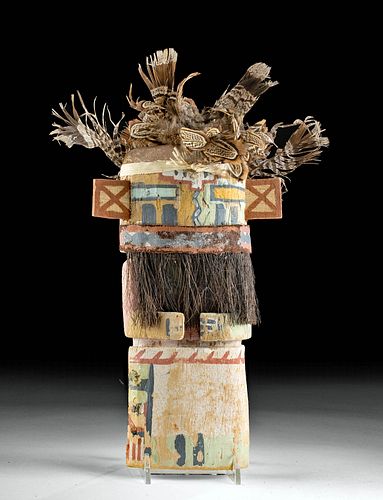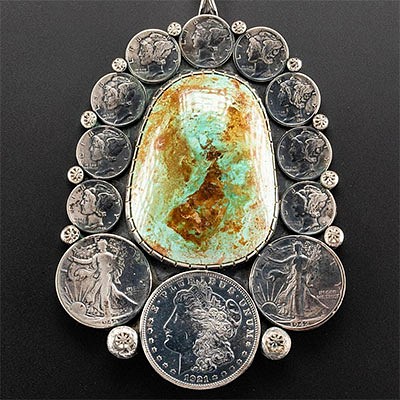1950s Native American Hopi / Navajo Kachina Doll
Lot 52b
About Seller
Artemis Fine Arts
686 S Taylor Ave, Ste 106
Louisville, CO 80027
United States
Selling antiquities, ancient and ethnographic art online since 1993, Artemis Gallery specializes in Classical Antiquities (Egyptian, Greek, Roman, Near Eastern), Asian, Pre-Columbian, African / Tribal / Oceanographic art. Our extensive inventory includes pottery, stone, metal, wood, glass and textil...Read more
Estimate:
$900 - $1,200
Absentee vs Live bid
Two ways to bid:
- Leave a max absentee bid and the platform will bid on your behalf up to your maximum bid during the live auction.
- Bid live during the auction and your bids will be submitted real-time to the auctioneer.
Bid Increments
| Price | Bid Increment |
|---|---|
| $0 | $25 |
| $300 | $50 |
| $1,000 | $100 |
| $2,000 | $250 |
| $5,000 | $500 |
| $10,000 | $1,000 |
| $20,000 | $2,500 |
| $50,000 | $5,000 |
| $100,000 | $10,000 |
| $200,000 | $20,000 |
About Auction
By Artemis Fine Arts
Feb 25, 2021
Set Reminder
2021-02-25 10:00:00
2021-02-25 10:00:00
America/New_York
Bidsquare
Bidsquare : American Frontier | Ethnographic | Tribal Art
https://www.bidsquare.com/auctions/artemis-gallery/american-frontier-ethnographic-tribal-art-6449
Featuring historical examples from the American, Spanish, and Mexican frontiers, as well as Native American, Ethnographic, Tribal, Oceanic, Spanish Colonial, more. All items offered for sale have been legally acquired, are legal to sell and are guaranteed to be as described or your money back. Artemis Fine Arts info@artemisfinearts.com
Featuring historical examples from the American, Spanish, and Mexican frontiers, as well as Native American, Ethnographic, Tribal, Oceanic, Spanish Colonial, more. All items offered for sale have been legally acquired, are legal to sell and are guaranteed to be as described or your money back. Artemis Fine Arts info@artemisfinearts.com
- Lot Description
Native American Indian, Southwest, Hopi or Navajo, ca. 1950s CE. A hand-carved and hand-painted wooden katsina/kachina with bird feathers atop the head and chocolate brown hairs, likely horse hair, attached below the neck that run over the torso. The visage is finely delineated with stylized eyes, tears, and symbolic motifs in hues of sky blue, cornflower blue, yellow, red, and white. To either side are appliques with red "X" motifs. Kachina figures are traditionally created as gifts for children representing kachina dancers and the supernatural katsinam beings they embody. Size: 5.75" W x 9.5" H (14.6 cm x 24.1 cm)
Plaza Dances may be either Mixed Katsina Dances (Soyohim) in which dancers representing all the different types of katsinas attend, or a dance that includes only katsinas of the same type. Regardless, in addition to bringing about rain and fertility, all of the katsinas have a distinct purpose. Dances may be performed to commemorate a special event such as recovery from an illness, the welcomed return of a son from the army, or a birthday. Nevertheless, these dances maintain a religion quality for the Hopis.
The Katsinam, supernatural beings who live in the high mountains of the San Francisco Peaks above traditional Hopi territory, speak to the Hopi through costumed dance and song. These dancers emerge from the round ceremonial kivas that are at the center of their communities, singly or in groups, and dance to the music of drums, rattles, and song. In imitation and representation of them are Katsina figures (katsina dolls, katsin-tihu), made of cottonwood root. Cottonwood is culturally symbolic because the cottonwood tree, once abundant in traditional Hopi lands, grows where water flows - thus, looking across a landscape, lines of cottonwood trees denote a water source in the desert. After carving, the figures are painted all over with whitewash, made from kaolin clay, and then painted in brilliant colors. Originally these were done using yucca brushes. Many of them are then decorated with other materials, like feathers, cloth, or fur. Katsina dolls are often given objects to hold which indicate their roles.
Provenance: private Glorieta, New Mexico, USA collection
All items legal to buy/sell under U.S. Statute covering cultural patrimony Code 2600, CHAPTER 14, and are guaranteed to be as described or your money back.
A Certificate of Authenticity will accompany all winning bids.
We ship worldwide and handle all shipping in-house for your convenience.
#161948Losses to feathers with bending and shedding/loosening from the top. Chipping and fading of pigments. Nice preservation of hair. Cord on verso for suspension.Condition
- Shipping Info
-
All shipping is handled in-house for your convenience. Your invoice from Artemis Gallery will include shipping calculation instructions. If in doubt, please inquire BEFORE bidding for estimated shipping costs for individual items.
-
- Buyer's Premium



 EUR
EUR CAD
CAD AUD
AUD GBP
GBP MXN
MXN HKD
HKD CNY
CNY MYR
MYR SEK
SEK SGD
SGD CHF
CHF THB
THB














